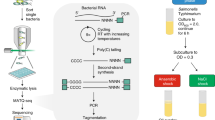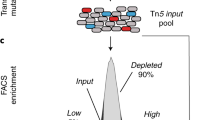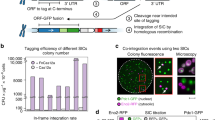Abstract
A fundamental goal in biotechnology and biology is the development of approaches to better understand the genetic basis of traits. Here we report a versatile method, trackable multiplex recombineering (TRMR), whereby thousands of specific genetic modifications are created and evaluated simultaneously. To demonstrate TRMR, in a single day we modified the expression of >95% of the genes in Escherichia coli by inserting synthetic DNA cassettes and molecular barcodes upstream of each gene. Barcode sequences and microarrays were then used to quantify population dynamics. Within a week we mapped thousands of genes that affect E. coli growth in various media (rich, minimal and cellulosic hydrolysate) and in the presence of several growth inhibitors (β-glucoside, D-fucose, valine and methylglyoxal). This approach can be applied to a broad range of traits to identify targets for future genome-engineering endeavors.
This is a preview of subscription content, access via your institution
Access options
Subscribe to this journal
Receive 12 print issues and online access
$209.00 per year
only $17.42 per issue
Buy this article
- Purchase on Springer Link
- Instant access to full article PDF
Prices may be subject to local taxes which are calculated during checkout





Similar content being viewed by others
Accession codes
References
Fox, R.J. et al. Improving catalytic function by ProSAR-driven enzyme evolution. Nat. Biotechnol. 25, 338–344 (2007).
Turner, N.J. Directed evolution drives the next generation of biocatalysts. Nat. Chem. Biol. 5, 567–573 (2009).
Winzeler, E.A. et al. Functional characterization of the S. cervisiase genome by gene geletion and parallel analysis. Science 285, 901–906 (1999).
Fodor, S. et al. Light-directed, spatially addressable parallel chemical synthesis. Science 251, 767–773 (1991).
Blanchard, A.P., Kaiser, R.J. & Hood, L.E. High-density oligonucleotide arrays. Biosens. Bioelectron. 11, 687–690 (1996).
Singh-Gasson, S. et al. Maskless fabrication of light-directed oligonucleotide microarrays using a digital micromirror array. Nat. Biotechnol. 17, 974–978 (1999).
Cleary, M.A. et al. Production of complex nucleic acid libraries using highly parallel in situ oligonucleotide synthesis. Nat. Methods 1, 241–248 (2004).
Ghindilis, A. et al. CombiMatrix oligonucleotide arrays: genotyping and gene expression assays employing electrochemical detection. Biosens. Bioelectron. 22, 1853–1860 (2007).
Yu, D. et al. An efficient recombination system for chromosome engineering in Escherichia coli. Proc. Natl. Acad. Sci. USA 97, 5978–5983 (2000).
Murphy, K. Use of bacteriophage lambda recombination functions to promote gene replacement in Escherichia coli. J. Bacteriol. 180, 2063–2071 (1998).
Zhang, Y., Buchholz, F., Muyrers, J. & Stewart, A.F. A new logic for DNA engineering using recombination in Escherichia coli. Nat. Genet. 20, 123–128 (1998).
Shoemaker, D.D., Lashkari, D.A., Morris, D., Mittmann, M. & Davis, R.W. Quantitative phenotypic analysis of yeast deletion mutants using a highly parallel molecular bar-coding strategy. Nat. Genet. 14, 450–456 (1996).
Cho, R.J. et al. Parallel analysis of genetic selections using whole genome oligonucleotide arrays. Proc. Natl. Acad. Sci. USA 95, 3752–3757 (1998).
Gill, R.T. et al. Genome wide screening for trait conferring genes using DNA micro-arrays. Proc. Natl. Acad. Sci. USA 99, 7033–7038 (2002).
Lynch, M.D., Warnecke, T. & Gill, R.T. SCALEs: multiscale analysis of library enrichment. Nat. Methods 4, 87–93 (2007).
Badarinarayana, V. et al. Selection analyses of insertional mutants using subgenic resolution arrays. Nat. Biotechnol. 19, 1060–1065 (2001).
Giaever, G. et al. Functional profiling of the Saccharomyces cerevisiae genome. Nature 418, 387–391 (2002).
Ho, C.H. et al. A molecular barcoded yeast ORF library enables mode-of-action analysis of bioactive compounds. Nat. Biotechnol. 27, 369–377 (2009).
Baba, T. et al. Construction of Escherichia coli K-12 in-frame, single-gene knockout mutants: the Keio collection. Mol. Syst. Biol. 2, 1–11 (2006).
Kitagawa, M. et al. Complete set of ORF clones of Escherichia coli ASKA library (a complete set of E. coli K-12 ORF archive): unique resources for biological research. DNA Res. 12, 291–299 (2006).
Datsenko, K. & Wanner, B. One-step inactivation of chromosomal genes in E. coli K12 using PCR products. Proc. Natl. Acad. Sci. USA 97, 6640–6645 (2000).
Ellis, H.M., Yu, D., DiTizio, T. & Court, D.L. High efficiency mutagenesis, repair, and engineering of chromosomal DNA using single-stranded oligonucleotides. Proc. Natl. Acad. Sci. USA 98, 6742–6746 (2001).
Datta, S., Costantino, N., Zhou, X. & Court, D.L. Identification and analysis of recombineering functions from Gram-negative and Gram-positive bacteria and their phages. Proc. Natl. Acad. Sci. USA 105, 1626–1631 (2008).
Wang, H. et al. Programming cells by multiplex genome engineering and accelerate evolution. Nature 460, 894–898 (2009).
Lutz, R. & Bujard, H. Independent and tight regulation of transcriptional units in Escherichis coli via the LacR/O, the TetR/O and AraC/I1–I2 regulatory elements. Nucleic Acids Res. 25, 1203–1210 (1997).
Shine, J. & Dalgarno, L. The 3′-terminal sequence of Escherichia coli 16S ribosomal RNA: complementarity to nonsense triplets and ribosome binding sites. Proc. Natl. Acad. Sci. USA 71, 1342–1346 (1974).
Kimura, M., Takatsuki, A., Yamaguchi, I. & Blasticidin, S. Deaminase gene from Aspergillus terreus (BSD): a new drug resistance gene for transfection of mammalian cells. Biochim. Biophys. Acta 1219, 653–659 (1994).
Pierce, S.E. et al. A unique and universal molecular barcode array. Nat. Methods 3, 601–603 (2006).
Baudin, A., Ozier-Kalogeropoulos, O., Denouel, A., Lacroute, F. & Culin, C. A simple and efficient method for direct gene deletion in Saccharomyces cerevisiae. Nucleic Acids Res. 21, 3329–3330 (1993).
Markham, N.R. & Zuker, M. DINAMelt web server for nucleic acid melting prediction. Nucleic Acids Res. 33, W577–W581 (2005).
Defez, R. & de Felice, M. Cryptic operon for beta-glucoside metabolism in Escherichia coli K12: genetic evidence for a regulatory protein. Genetics 97, 11–25 (1981).
Meijnen, J.P., de Winde, J.H. & Ruijssenaars, H.J. Engineering Pseudomonas putida S12 for efficient utilization of D-xylose and L-arabinose. Appl. Environ. Microbiol. 74, 5031–5037 (2008).
Zhu, M.M., Skraly, F.A. & Cameron, D.C. Accumulation of methylglyoxal in anaerobically grown Escherichia coli and its detoxification by expression of the Pseudomonas putida glyoxalase i gene. Metab. Eng. 3, 218–225 (2001).
Gort, A.S., Ferber, D.M. & Imlay, J.A. The regulation and role of the periplasmic copper, zinc superoxide dismutase of Escherichia coli. Mol. Microbiol. 32, 179–191 (1999).
Sutton, A., Newman, T., Francis, M. & Freundlich, M. Valine-resistant Escherichia coli K-12 strains with mutations in the ilvB operon. J. Bacteriol. 148, 998–1001 (1981).
Weinstock, O., Sella, C., Chipman, D.M. & Barak, Z. Properties of subcloned subunits of bacterial acetohydroxy acid synthases. J. Bacteriol. 174, 5560–5566 (1992).
Wessler, S.R. & Calvo, J.M. Control of leu operon expression in Escherichia coli by a transcription attenuation mechanism. J. Mol. Biol. 149, 579–597 (1981).
Sycheva, E.V. et al. Overproduction of noncanonical amino acids by Escherichia coli cells. Microbiology 76, 712–718 (2007).
Chen, S.F., Mowery, R.A., Castleberry, V.A., van Walsum, G.P. & Chambliss, C.K. High-performance liquid chromatography method for simultaneous determination of aliphatic acid, aromatic acid and neutral degradation products in biomass pretreatment hydrolysates. J. Chromatogr. A 1104, 54–61 (2006).
Mohagheghi, A. & Schell, D.J. Impact of recycling stillage on conversion of dilute sulfuric acid pretreated corn stover to ethanol. Biotechnol. Bioeng. 105, 992–996 (2010).
Ferrante, A.A., Augliera, J., Lewis, K. & Klibanov, A.M. Cloning of an organic solvent-resistance gene in Escherichia coli: the unexpected role of alkylhydroperoxide reductase. Proc. Natl. Acad. Sci. USA 92, 7617–7621 (1995).
Poole, L.B. Bacterial defenses against oxidants: mechanistic features of cysteine-based peroxidases and their flavoprotein reductases. Arch. Biochem. Biophys. 433, 240–254 (2005).
Seaver, L.C. & Imlay, J.A. Alkyl hydroperoxide reductase is the primary scavenger of endogenous hydrogen peroxide in Escherichia coli. J. Bacteriol. 183, 7173–7181 (2001).
Kohanski, M.A., Dwyer, D.J., Hayete, B., Lawrence, C.A. & Collins, J.J. A common mechanism of cellular death induced by bactericidal antibiotics. Cell 130, 797–810 (2007).
Lu, T.K., Khalil, A.S. & Collins, J.J. Next-generation synthetic gene networks. Nat. Biotechnol. 27, 1139–1150 (2009).
Datta, S., Constantino, N. & Court, D.L. A set of recombineering plasmids for gram-negative bacteria. Gene 379, 109–115 (2006).
Pierce, S.E., Davis, R.W., Nislow, C. & Giaever, G. Genome-wide analysis of barcoded Saccharomyces cerevisiae gene-deletion mutants in pooled cultures. Nat. Protoc. 2, 2958–2974 (2007).
Nour-Eldin, H.H., Hansen, B.G., Norholm, M.H.H., Jensen, J.K. & Halkier, B.A. Advancing uracil-excision based cloning towards an ideal technique for cloning PCR fragments. Nucleic Acids Res. 34, e122 (2006).
Dean, F.B., Nelson, J.R., Giesler, T.L. & Lasken, R.S. Rapid amplification of plasmid and phage DNA using Phi29 DNA polymerase and multiply-primed rolling circle amplification. Genome Res. 11, 1095–1099 (2001).
Perni, S., Andrew, P.W. & Shama, G. Estimating the maximum growth rate from microbial growth curves: definition is everything. Food Microbiol. 22, 491–495 (2005).
Acknowledgements
We thank D. Court (Center for Cancer Research, National Cancer Institute at Frederick, Maryland) for sharing plasmid pSIM5, C. Nislow and G. Giaever (University of Toronto, Ontario) for help with microarray analysis, A. Mohagheghi and M. Zhang (US National Renewable Energy Laboratories) for hydrolysate samples, M. O'Donnell for help in preparation of selective agar plates, Agilent for access to the Oligonucleotide Library Synthesis product, and H. Marshall and the University of Colorado Microarray Facility for molecular barcode genotyping. The authors appreciate financial support provided by Shell, the Colorado Center for Biorefining and Biofuels (http://www.C2B2web.org) and the Colorado Energy Initiative (http://rasei.colorado.edu).
Author information
Authors and Affiliations
Contributions
J.R.W. and R.T.G. conceived the study; J.R.W. designed and performed all experiments except for growth selections and allele confirmations in hydrolysate, which were conducted by P.J.R.; A.K.-F. aided J.R.W. in selection of targeting sequences and selection of barcode tags; A.K.-F. and P.J.R. assigned gene ontology terms; L.B.A.W. aided J.R.W. in selection design and microarray analysis; L.B.A.W. constructed circle plots; P.J.R., A.K.-F. and L.B.A.W. helped in manuscript preparation; J.R.W. and R.T.G. wrote the manuscript; R.T.G. supervised all aspects of the study.
Corresponding author
Ethics declarations
Competing interests
The authors declare no competing financial interests.
Supplementary information
Supplementary Text and Figures
Supplementary Tables 2–6, Supplementary Notes and Supplementary Figs. 1–4 (PDF 5193 kb)
Supplementary Table 1
Targeting oligo sequences, tag sequences, and 2-state hybridization energies. (XLS 2731 kb)
Rights and permissions
About this article
Cite this article
Warner, J., Reeder, P., Karimpour-Fard, A. et al. Rapid profiling of a microbial genome using mixtures of barcoded oligonucleotides. Nat Biotechnol 28, 856–862 (2010). https://doi.org/10.1038/nbt.1653
Received:
Accepted:
Published:
Issue Date:
DOI: https://doi.org/10.1038/nbt.1653
This article is cited by
-
DNA synthesis technologies to close the gene writing gap
Nature Reviews Chemistry (2023)
-
Biotechnological advances for improving natural pigment production: a state-of-the-art review
Bioresources and Bioprocessing (2022)
-
Synthetic biology promotes the capture of CO2 to produce fatty acid derivatives in microbial cell factories
Bioresources and Bioprocessing (2022)
-
Establishment of genomic library technology mediated by non-homologous end joining mechanism in Yarrowia lipolytica
Science China Life Sciences (2021)
-
Stress-tolerant non-conventional microbes enable next-generation chemical biosynthesis
Nature Chemical Biology (2020)



